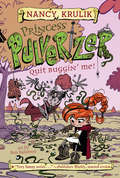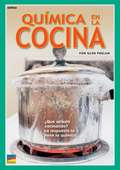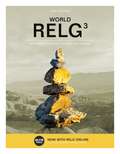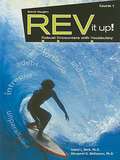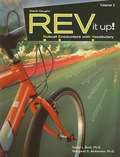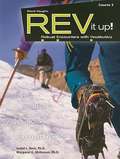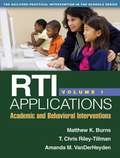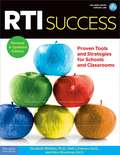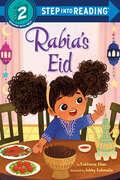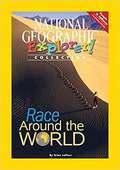- Table View
- List View
Quit Buggin' Me! #4 (Princess Pulverizer #4)
by Nancy Krulik Ben BalistreriPrincess Pulverizer may not be a knight yet, but she won't let that stop her from saving the day!Princess Pulverizer and her friends, Lucas and Dribble the dragon, are on the hunt for another good deed to complete on her Quest of Kindness. So when they hear about a mysterious evil beast who's been capturing townspeople, the trio sets out to find it and rescue the prisoners. But when Lucas and Dribble get caught themselves, it's up to Princess Pulverizer to free her friends!
Quizás algo hermoso: Cómo el arte transformó un barrio (¡Arriba la Lectura!, Read Aloud Module 2 #2)
by Rafael López Theresa Howell F. CampoyNIMAC-sourced textbook
REA Accounting Systems and Analytics
by Cheryl L. Dunn Gregory J. GerardREA Accounting Systems and Analytics
READY New York CCLS, Common Core Edition, Mathematics Instruction [Grade] 6
by Curriculum AssociatesNIMAC-sourced textbook
RELG (Third Edition): World
by Robert R. Van VoorstLearn about World Religions YOUR Way with RELG: WORLD, 3th Edition! Undertake a fascinating journey as you explore the belief systems that have shaped societies throughout history. Pair your easy-reference, visually-engaging text with MindTap for access to highlighting and notetaking features, chapter quizzes, and ready-made study tools. MindTap for RELG: WORLD, 3th Edition allows easy exploration of world religions anywhere, anytime.
REV It Up! Robust Encounters with Vocabulary, Course 1
by Isabel L. Beck Margaret G. MckeownNIMAC-sourced textbook
REV It Up! Robust Encounters with Vocabulary, Course 2
by Isabel L. Beck Margaret G. MckeownNIMAC-sourced textbook
REV It Up! Robust Encounters with Vocabulary, Course 3
by Isabel L. Beck Margaret G. MckeownNIMAC-sourced textbook
RPWD Act - Hindi-2016: आरपीडब्ल्यूडी ॲक्ट - हिंदी-2016
by Rpwd Actदिव्यांगजनों के अधिकारों पर संयुक्त राष्ट्र अभिसमय और उससे संबंधित या उसके आनुषंगिक विषयों को प्रभावी बनाने के लिए अधिनियम दिए गए है। संयुक्त राष्ट्र महासभा ने, 13 दिसम्बर, 2006 को दिव्यांगजनों के अधिकारों पर उसके अभिसमय को अंगीकृत किया था, और पूर्वोक्त अभिसमय दिव्यांगजनों के सशक्तिकरण के लिए सिद्धांत अधिकथित करता है।
RTI Applications, Volume 1: Academic and Behavioral Interventions (The Guilford Practical Intervention in the Schools Series #1)
by Matthew K. Burns T. Chris Riley-Tillman Amanda M. VanDerHeydenThis book addresses a crucial aspect of sustaining a response-to-intervention (RTI) framework in a school: selecting interventions with the greatest likelihood of success and implementing them with integrity. Leading RTI experts explain how to match interventions to students' proficiency levels, drawing on cutting-edge research about the stages of learning. Effective academic and behavioral interventions for all three tiers of RTI are described in step-by-step detail and illustrated with vivid case examples. In a large-size format with lay-flat binding for easy photocopying, the book features more than 40 reproducible planning tools and other helpful forms. Purchasers also get access to a Web page where they can download and print the reproducible materials.
RTI Made Objective
by Muthuswamy Brinda SanjeevThis book contains the multiple choice question on Right To Information act. This covers the basic questions of the RTI act. Very useful for department & internal exams of govt of India.
RTI Success: Proven Tools And Strategies For Schools And Classrooms
by Elizabeth Whitten Kelli J. Esteves Alice WoodrowThis practical, ready-to-use resource gives teachers and administrators the tools to successfully implement RTI or strengthen an existing program to target students' specific needs. Response to Intervention allows educators to assess and meet the needs of struggling students before they have fallen too far behind. Three expert authors explore this multi-tiered system of support (MTSS), offering over one hundred research-based, instructional techniques and interventions for use in diverse settings, advice on creating personal and positive learning environments, information on co-teaching, and approaches to purposeful grouping. Included in the book and as digital downloads are easy-to-use customizable forms to streamline assessment, implementation, and documentation. Also included is an extensive list of references and resources for further exploration.
Raajyashastra-1 1st PUC: ರಾಜ್ಯಶಾಸ್ತ್ರ,-1 ಪ್ರಥಮ ಪಿ.ಯು.ಸಿ.
by Padavi Poorva Shikshana Ilaakheಇದು ರಾಜ್ಯಶಾಸ್ತ್ರ, ಕನ್ನಡ, ಸಾಹಿತ್ಯ ಸಂಚಲನ ಪ್ರಥಮ ಪಿ.ಯು.ಸಿ. ತರಗತಿಯ (ಕನ್ನಡ ಮಾಧ್ಯಮ) ವಿದ್ಯಾರ್ಥಿಗಳಿಗೆ ಈ ಶೈಕ್ಷಣಿಕ ಪುಸ್ತಕವು ಉಪಯುಕ್ತವಾಗಿದೆ.
Rabbit's Garden (Fountas & Pinnell Classroom, Guided Reading Kindergarten)
by Donna Gephart Stephen StoneNIMAC-sourced textbook
Rabbit's Roller Skates (Fountas & Pinnell Classroom, Guided Reading)
by Jennifer Morris Jacqueline AdamsNIMAC-sourced textbook
Rabbit's Snow Dance: A Traditional Iroquois Story (Into Reading, Read Aloud Module 4 #2)
by Joseph Bruchac James Bruchac Jeff NewmanNIMAC-sourced textbook
Rabbit's Surprise (Fountas & Pinnell Classroom, Guided Reading)
by Mike Spoor Kate SpringerNIMAC-sourced textbook. Poor Mole! Mole is sad. Rabbit wants to cheer his friend up. But how?
Rabbit, Rabbit (Fountas & Pinnell Classroom, Guided Reading)
by Mark Beech Shannon PasseNIMAC-sourced textbook. She Forgot to Say It! Miss Fiske is a quiet, tidy librarian. So how does she end up making jellyfish chowder on a pirate ship?
Rabia's Eid (Step into Reading)
by Rukhsana KhanJoin a young girl and her family in this Step 2 reader as they celebrate Eid-al-fitr, a holiday that marks the end of the Islamic holy month of Ramadan. Perfect for readers ages 4-6.It's Eid-al-fitr—the last day of Ramadan, which means it is the last day for Rabia to fast with the rest of her family and she has never done it before. Rabia is so excited! She eats just before sunrise and then the day of fasting begins! Rabia gets to have her hands painted with henna, wear a new dress, and put her family's donation in the box at the mosque. It's a special Eid all around!Step 2 Readers use basic vocabulary and short sentences to tell simple stories, for children who recognize familiar words and can sound out new words with help.
Race Around the World, Pathfinder Edition (National Geographic Explorer Collection)
by Beth Geiger Brian LaFleurNIMAC-sourced textbook
Race Around the World, Pioneer Edition (National Geographic Explorer Collection)
by Beth Geiger Brian LaFleurNIMAC-sourced textbook
Race and Manifest Destiny: Origins of American Racial Anglo-Saxonism
by Reginald HorsmanAmerican myths about national character tend to overshadow the historical realities. Reginald Horsman's book is the first study to examine the origins of racialism in America and to show that the belief in white American superiority was firmly ensconced in the nation's ideology by 1850. <P><P>The author deftly chronicles the beginnings and growth of an ideology stressing race, basic stock, and attributes in the blood. He traces how this ideology shifted from the more benign views of the Founding Fathers, which embraced ideas of progress and the spread of republican institutions for all. He finds linkages between the new, racialist ideology in America and the rising European ideas of Anglo-Saxon, Teutonic, and scientific ideologies of the early nineteenth century. Most importantly, however, Horsman demonstrates that it was the merging of the Anglo-Saxon rhetoric with the experience of Americans conquering a continent that created a racialist philosophy. Two generations before the "new" immigrants began arriving in the late nineteenth century, Americans, in contact with blacks, Indians, and Mexicans, became vociferous racialists. <P><P>In sum, even before the Civil War, Americans had decided that peoples of large parts of this continent were incapable of creating or sharing in efficient, prosperous, democratic governments, and that American Anglo-Saxons could achieve unprecedented prosperity and power by the outward thrust of their racialism and commercial penetration of other lands. The comparatively benevolent view of the Founders of the Republic had turned into the quite malevolent ideology that other peoples could not be "regenerated" through the spread of free institutions.
